Four thousand years ago, a remarkable culture emerged in the Eastern Eurasian steppes north of the Great Wall of China, in what is now Inner Mongolia. Herding, hunting on horseback, and agriculture characterized the way of life for the pastoral nomads of this region, and the art they produced reflects the equestrian culture that evolved over the centuries. Lightweight and portable, the weapons, bronze and gold belt plaques and chariot fittings, and objects of personal adornment display skilled craftsmanship and highly-abstract designs, featuring animals, both wild and domesticated - tigers, bears, ibex, horses, camels - as well as raptors, dragons, and other mythical creatures. Trade, intermarriage and warfare between the nomadic peoples and their settled Chinese neighbours during the first millennium BC led to a complex interrelationship that contributed to the cultural development of both groups. This text examines the artistic exchange between them and chronicles the culture of the pastoral peoples by focusing on nearly 200 artefacts from the distinguished collection of Eugene V.
Thaw, with additional works selected from other private collections and from The Metropolitan Museum of Art.
- ISBN10 0300096887
- ISBN13 9780300096880
- Publish Date 31 December 2002 (first published 1 January 2002)
- Publish Status Active
- Out of Print 2 September 2011
- Publish Country US
- Imprint Yale University Press
- Format Hardcover
- Pages 320
- Language English
